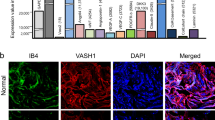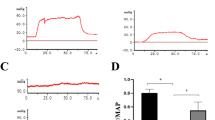Abstract
Nitric oxide (NO) is the principal mediator of penile erection. NO is synthesized by a variety of nitric oxide synthases (NOS). It has been demonstrated that a decrease in NOS activity, as observed in aging, is associated with a diminished erectile response. The objective of this study was to determine if adenoviral-mediated gene transfer of eNOS could reverse age-related erectile dysfunction in the rat. Two groups of animals were transfected with adenoviruses: (1) aged rats (60 weeks) with AdRSVβgal; and (2) aged rats (60 weeks) with AdRSVeNOS. Five days after transfection, these study animals underwent cavernosal nerve stimulation (CNS) to assess erectile function and their responses were compared with young (20 weeks) control rats. Cross-sections of the rat penises transfected with AdRSVeNOS were examined after trichrome staining. Adenoviral transduction efficiency of β-galactosidase reporter gene was measured by a galacto-light chemiluminescent reporter gene assay in cavernosal tissues of rats administered AdRSVβgal. The transgene expression of eNOS was examined by RT-PCR in rats transfected with AdRSVβgal and AdRSVeNOS. eNOS and iNOS protein levels were measured by Western blot analysis, and cGMP levels were assessed in cavernosal tissue by enzyme immunoassay. Adenoviral expression of the β-galactosidase reporter gene was observed in cavernosal tissue for up to 30 days, with peak expression registered at 5 days after intracavernosal administration of AdRSVβgal. Cross-sections of the rat penises transfected with the AdRSVeNOS revealed no pathological (morphological or histological) changes. Five days after administration of AdRSVeNOS, eNOS protein, mRNA and cGMP levels in the corpora cavernosa were significantly increased (P<0.05), while iNOS protein levels remained unchanged (P>0.05). In conclusion, enhanced expression of eNOS employing an adenoviral vector significantly increased the erectile response to cavernosal nerve stimulation in the aged rat, similar to the response observed in younger rats. These data suggest that in vivo adenoviral gene transfer of eNOS can physiologically improve erectile function in the aged rat.
This is a preview of subscription content, access via your institution
Access options
Subscribe to this journal
Receive 8 print issues and online access
$259.00 per year
only $32.38 per issue
Buy this article
- Purchase on Springer Link
- Instant access to full article PDF
Prices may be subject to local taxes which are calculated during checkout
Similar content being viewed by others
Author information
Authors and Affiliations
Corresponding author
Rights and permissions
About this article
Cite this article
Bivalacqua, T., Champion, H., Mehta, Y. et al. Adenoviral gene transfer of endothelial nitric oxide synthase (eNOS) to the penis improves age-related erectile dysfunction in the rat. Int J Impot Res 12 (Suppl 3), S8–S17 (2000). https://doi.org/10.1038/sj.ijir.3900556
Published:
Issue Date:
DOI: https://doi.org/10.1038/sj.ijir.3900556
Keywords
This article is cited by
-
Unveiling the molecular Hallmarks of Peyronie’s disease: a comprehensive narrative review
International Journal of Impotence Research (2024)
-
Emerging Treatments for Erectile Dysfunction: a Review of Novel, Non-surgical Options
Current Urology Reports (2019)
-
Aqueous extract of Lespedeza cuneata improves male menopause by increase of nitric oxide and dihydrotestosterone
Food Science and Biotechnology (2019)
-
Mesenchymal stem cell-based gene therapy for erectile dysfunction
International Journal of Impotence Research (2016)
-
Emerging tools for erectile dysfunction: a role for regenerative medicine
Nature Reviews Urology (2012)



